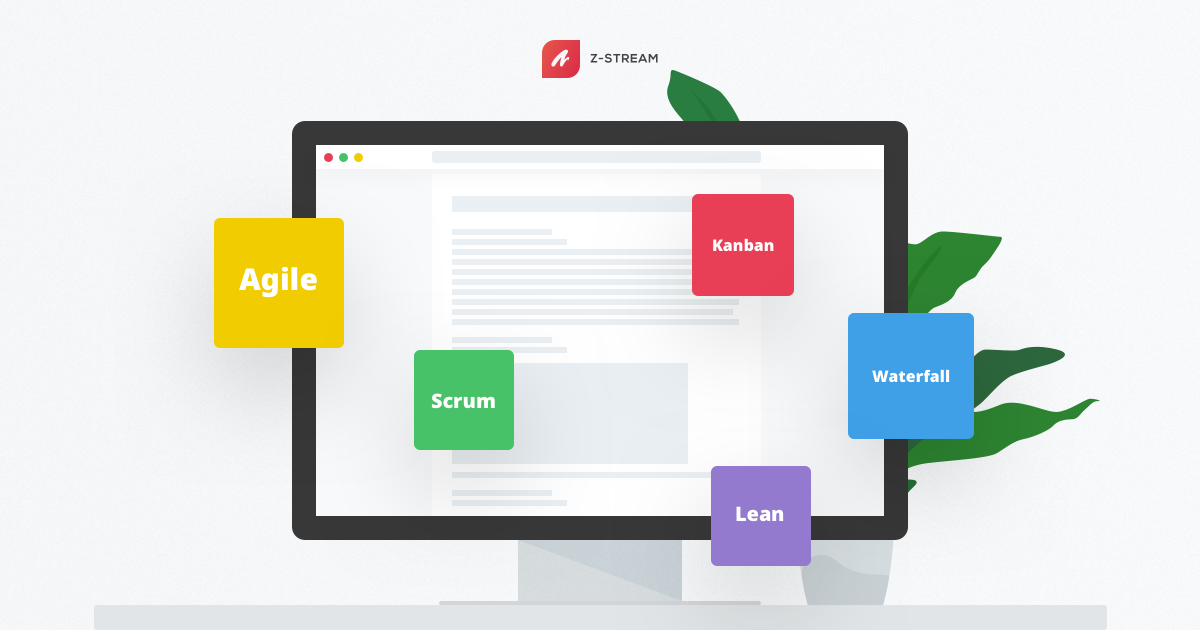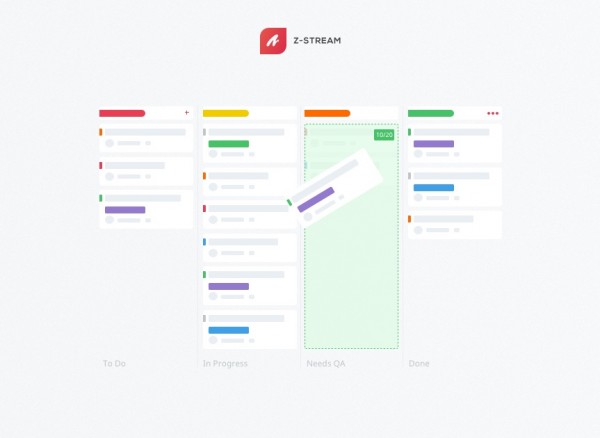
What is Project Management Methodology?
A methodology is a standardized set of rules or methods in a given discipline. When one hears the term Project Management Methodology, it refers to the various processes that project management teams employ to structure their work. There are a huge number of project management methodologies and each can be used independently or blended with other methodologies depending on the experience level of the team and what the team needs to focus on most.
Top Project Management Methodologies
Being familiar with the various types of project management methodologies is not very helpful unless we understand the fundamentals of each methodology and why a specific methodology is chosen for a project. All project management methodologies emphasize some principle or group of principles to focus on, such as reducing variance, iterating product versions rapidly, or facilitating productive communication. Many methodologies also prescribe a more explicit framework based on these principles, for things like meetings, release planning, and ensuring continuous improvement.
Agile
Agile isn’t one single project management methodology, but rather a broad set of principles used in software development. These principles are set forth in what is known as the Agile Manifesto, which includes four main values:
- Individuals and interactions should be held in higher regard than processes and tools
- Delivering working software is more important than creating full documentation
- Stakeholder collaboration is more important than negotiating contracts
- Responding to change quickly is more important than sticking to a strict plan
These principles are the core of agile philosophy, from which spring more specific methodologies that focus on different parts of the product development process.
Advantages of Using the Agile Philosophy
The advantages of Agile philosophy in every facet of business are invaluable, driving teams to focus on the ever-evolving demands of clients. This leads to:
- Increased customer satisfaction
- Higher quality products
- Maintaining better control over projects
- A faster return on investment
- Reducing risk
Disadvantages of Agile Model
The Agile model is a mindset and cultural philosophy, and because of this, it is subjective. There may be times when emphasis on documentation or processes is actually lacking. Without practical considerations, Agile methodology can upset the balance between delivering new functionality and maintaining a solid foundation for your product.
Waterfall Methodology
The Waterfall project management methodology is often referred to as the Software Development Life Cycle (SDLC). This project management methodology differs from Agile methodology in that it focuses more on creating a solid plan and executing it in the right way, one time through. The Waterfall model entails extensive, intricate planning and sticking to a strict set of goals in a single, drawn out release. Each phase of the plan must be completed to perfection before the next phase will commence.
Advantages of the Waterfall Model
Though sometimes viewed as an inefficient and inflexible model in today’s project management world, the advantages of the Waterfall methodology include the ability for each team member to thoroughly understand the process to follow, clearly outlining each step along the way from start to finish. With the Waterfall project management methodology, the end goal is understood from the start, helping team members stay focused and keeping their eyes on the prize.
It is best utilized for shorter projects since there is less of a chance for requirements to change, compared to long-term projects where goals and requirements can change drastically over time.
Disadvantages of Waterfall Model
Perhaps one of the biggest disadvantages of the Waterfall model that draws the ire of many is the fact that deviation from the set plan is difficult. There is also little attention given to the customer or end-user and it the product development plan is mainly intended for use by internal team members. Customers want their input taken seriously and accounted for in the product development process but the Waterfall model can hinder your team’s ability to incorporate unexpected client needs into the final product.
Scrum
Think of Scrum as a complementary framework to Agile, incorporating agile principles into a series of meetings and “artifacts” to facilitate the delivery of high-value functionality. Because it can be adapted and customized, scrum can be considered both a project management framework and methodology. The Scrum ceremonies, artifacts, and steps aim to improve the speed of development, communication, and team collaboration.
The intention of using Scrum methodology is to unshackle self-directed teams and allow for a bit of beneficial competition to provide the exceptional results as quickly as possible. Some of the terms you may hear being tossed around by team members are “sprints, daily scrums, backlogs, and burndown chart”:
- Sprints are periods of time within a release that last from 1 to 4 weeks, at the end of which a certain chunk of product functionality is released.
- Sprint backlogs are lists of tasks that are divided amongst the team during one development cycle.
- Daily scrums are daily reports and collaboration meetings that take place during sprints.
- Burndown charts show the work left to be done (backlog) versus how much time is left to complete the work. Using a burndown chart, the team can see its own velocity and how fast it needs to go to complete the tasks in the sprint.
Advantages of Scrum
The benefits of Scrum are found mostly in the flexibility and collaborative nature of the framework. A Scrum Master leads the daily scrums, sprint demos, and sprint reviews in such a way that the whole team is on the same page as to where everything is at during any given point in the project. An experienced Scrum Master is focused on ensuring the team is consistently improving and honing their skills.
Another big advantage of Scrum is that products can be developed, perfected, and released relatively quickly as mistakes are acknowledged and amended before getting too far into the process.
Disadvantages of Scrum
The Scrum methodology does come with some disadvantages, though. The Scrum process was originally developed to be most suitable in the software development environment; because of this, other agencies may face more constraints such as budget flexibility, scope, and timelines. Additionally, the Scrum project management methodology can sometimes cause what is known as scope creep, which is where the project management leaders will continually find new functionality that needs to be added.
This project management methodology may be right for your project if the project is short, moves fast, and you have a small, highly dedicated team.
Kanban
Efficiency is the goal of the Kanban project management methodology. Incorporating lean principles and strict efficiency processes, Kanban methodology shares many similarities with Scrum. One major difference in Kanban from the other project management methodologies discussed previously is that it doesn’t have stipulated roles. Instead, Kanban works to keep the team focused on the most important and urgent tasks at hand and nothing else.
The fundamental processes are conceptualizing the workflow, restricting the amount of work in progress, analyzing lead times, making process policies explicit, and continuously evaluating optimization opportunities.
Advantages of the Kanban System
The Kanban methodology’s goal is to increasingly produce a better quality product that is released earlier than expected and on a regular basis. Another advantage of Kanban is that it works very well in operational and maintenance departments where the focus often changes repeatedly.
Many online collaboration tools are based on the Kanban system where there are simply cards denoting tasks that are moved from one column (eg. “To Do”) to the next (eg. “In Progress”) as the project progresses. This process is extremely valuable for visualization purposes and pivoting around new priorities as the need arises.
Kanban methodology is excellent for projects where clients change their minds often. If the project requires continuous, steady output, such as production, support, and maintenance departments, this is a logical methodology that will work well to align product and development teams with client goals.
Disadvantages of the Kanban System
The biggest disadvantage of the Kanban methodology is the potential for boards to become outdated if not properly maintained. Also, trying to provide too much intricate detail can overly-complicate the board. This can lead to confusion.
If the project has strict timeframes, the Kanban methodology may not work well since the whole premise is to allow for flexibility of deadlines.
Lean
As the name implies, the Lean methodology targets conservation of resources to improve efficiency and accomplish more with fewer resources. If Agile means flexibility, Lean encompasses supercharged flexibility. The Lean project management methodology is a theme comprised of principles. The foundation of Lean thinking relies on the ability to recognize and address the three most common causes of inefficiency and waste, also known as the 3Ms:
- Muda – eliminating waste in a process that does not ultimately benefit the customer
- Mura – eliminating variations in practices in favor of more standardized practices
- Muri – eliminating overload so as to not cause burnout and chaotic multi-tasking as the firm tries to address multiple projects at once
Advantages of Lean Methodology
The most obvious advantage of Lean project management is cutting overhead, but it goes deeper than that. Wasteful practices kill productivity and can diminish team member morale. When a project manager sets out to build a Lean culture, input from the entire team is required and that boosts collaboration and cohesiveness of the entire team, making them feel like their opinions are heard and valued.
Eradicating fluff and fodder from product development processes is the essence of Lean methodology. It works well in nearly every facet of business and is the backbone of efficiency. In today’s business environment, Lean operations are increasingly competitive and outperform outdated ways of thinking; rendering the idea of “doing things the way they have always been done” obsolete.
Disadvantages of Lean
Occasionally, trying to go too lean will actually work against an organization and cause new inefficiencies. The returns on Lean project management will also decrease over time, with the highest returns seen immediately, but with continued trimming will impact the overall processes less and less. Another pitfall can be bottlenecks forming in the production line as it creates a very low margin for error. One hiccup in the process can cause delays, lower throughout and ultimately work against the goal of efficiency.
Finally, if an organization tries too hard to push and squeeze more efficiency from the processes, it could also work against team member morale. It can actually shift the positive appreciation for efficiency into a feeling of frustration as employees begin to feel like leaders are undermining their hard work and pushing too hard to do more with less. It can quickly become a slippery-slope if leaders are not careful in their analysis and approach to trimming the fat.
PRINCE 2
The PRINCE2 project management methodology is an acronym that stands for PRojects IN Controlled Environments and is a set of processes. It is the most commonly used project management methodology in the UK government and is currently being adopted more widely throughout IT projects in the US government as well. The PRINCE2 project management process focuses on dividing projects into several stages, each one having their own clearly defined plans and processes.
PRINCE2 projects are overseen by a board which is responsible for the overall success of the project and how the team will be structured. The board will appoint a project manager who will oversee the day-to-day operations, reporting back to the board on a regular basis. Because of this structure, the PRINCE2 project management methodology gives product teams better control over resources and the ability to reduce risk when to board sees it ahead.
Advantages of PRINCE2
Because of the stringent planning and processes involved in PRINCE2 methodology, it is incredibly thorough and effective for running large projects with foreseeable circumstances. Because PRINCE2 divides projects into smaller stages, it makes it easier to manage each step more efficiently. Perhaps the best feature of using this methodology is that it drastically improves the communication between team members, the board, stakeholders, and customers.
Disadvantages of PRINCE2
What can arguably be considered a disadvantage of the PRINCE2 methodology is that it focuses on strict adherence to the plans set in place, and discourages straying from the original plan, the exact opposite of the Agile project management methodology. Also, because the planning is so thorough, it may actually hinder progress in smaller projects.
Critical Path Method
The Critical Path Method, also known as CPM in project management, follows a logical sequence of planning steps to create a model for the project’s timeframes for each step. The process involves breaking down each step and determining the time it will take to complete each step from start to finish. It is commonly used in conjunction with the PERT (Program Evaluation and Review Technique) method.
Advantages of Critical Path Method
The advantage of the Critical Path Method lies in how it constructs the model for the project using the following formula:
- Identifying all activities needed to complete the project
- How long each activity would logically take to complete
- How the tasks are connected to one another and how a delay in one task may affect others
- Determining the likely outcome and timeframe of each milestone
Critical Path methodology gives the entire team a highly accurate (though likely still imperfect) idea of what is expected and when.
Disadvantages of Critical Path Method
Because only estimations are used for determining the timeframes, the disadvantage of using the Critical Path Method becomes evident when there is a delay in one step of the process that affects the rest of the project. Similar to a cascading effect, if the delay is significant enough, the remaining steps in the project would need to be reevaluated and adjustments to expected outcomes will have to be made.
This method is most useful in projects where there are little to no surprises that may arise during the course of the project and things can move along predictably.
Six Sigma
The Six Sigma methodology is a highly disciplined perspective applied to project management. It focuses on data and is used for process improvement. It is commonly used within large corporations to help them understand a customer’s needs better and eliminate defects and waste. After careful analysis of statistics from the company and external sources, Six Sigma methodologies are used for identifying and remedying problems that exist across all departments, including production, marketing, sales, and administration.
There are two prominent methodologies of Six Sigma: DMAIC and DMADV.
DMAIC is driven by data and focused on the improvement of existing products and processes. Utilize the DMAIC process to go above and beyond your customer’s expectations when improving your product by following the five phases of this methodology:
- D – Define
- M – Measure
- A – Analyze
- I – Improve
- C- Control
DMADV is also driven by data but is focused on designing new products and processes, as opposed to existing products. It is a highly utilized methodology as a DFSS (Design for Six Sigma) that puts customer needs and expectations into the spotlight as one of the highest priorities. The five phases for this methodology are:
- D – Define
- M – Measure
- A – Analyze
- D – Design
- V – Verify
Advantages of Six Sigma Methodology
The advantages of Six Sigma are numerous, as is it generates a more thorough understanding of changing customer requirements thereby reducing cost and waste, improving the quality of the product, reducing delivery delays, sustaining iterative improvement, and enhancing a company’s competitive advantage.
Disadvantages of Six Sigma Methodology
Because of the rigidity of the Six Sigma methodology, it can lead to bureaucracy and bottle-necking in processes. Another disadvantage of Six Sigma is that it can tend to hinder creativity in problem-solving, creating further delays for teams that need to push conceptual boundaries in designing their product. It can also lead to issues with profitability in some areas, such as not implementing an inexpensive process that may decrease the number of defects in final products in favor of maintaining the designated Six Sigma defect rate.
GTD Methodology
Getting Things Done (GTD) methodology is the process of going from the idea stage to the action stage. It is commonly referred to as a life methodology and used in life coaching to help people go from just thinking about something they want to do to actually doing it. The GTD System follows a relatively simple process of discovery and action:
- Capture – Collect ideas and interests
- Clarify – Figure out what they could mean to you or the business
- Organize – Analyze and compile the ideas in workable strategies
- Reflect – Review them to find the next step
- Engage – Act on the next step
As you can see, it is literally just about Getting Things Done. It is a philosophy that leads to creating a process. The GTD methodology calls for one to find an incomplete task that distracts, annoys or interests you. Then defining what “done” means. Once you have established what the problems and the solutions are, you can better identify the next move to get you from point A to point B.
GTD Advantages
The advantage of the GTD method is that you can take the strategies you come up with and analyze each idea and step to fit into one of eight actions.
- Trash the idea
- Put it on the “maybe” or “someday” list
- File it away for reference later
- Put it on the project list
- Complete it immediately if it is a small task
- Delegate it to someone else
- Determine it to be the “next action”
- Put it on your calendar
The GTD process is about gaining control and perspective on the tasks that lie before you, as opposed to them controlling you. For instance, when you decide you need to clean up your email inbox, this method allows you to avoid trying to make your inbox a “to do” list, and you would avoid putting clarified items back into the inbox. It is a step in the rest of the process and should be seen as such, meaning emptying it doesn’t mean you’re finished, it just means you’re applying the “capture, clarify, organize” step to your overall workload.
GTD Disadvantages
The GTD method seems simple, yet it can be fairly complex. To fully understand and reap the benefits of the system, you have to utilize it in full. If you find yourself inundated with changing tasks on a daily basis, trying to implement the GTD system can become overwhelming and ultimately work against your efforts. It is also very time-consuming, not just in the implementation, but in the maintenance of it as well. It’s not simply creating checklists; it is an overall philosophy to apply to every aspect of your life, which is difficult to adopt and maintain for anybody.
So.. How To Choose The Right Project Management Methodology?
Finding the right project management methodology for each person and company is going to be a process. There is really no general rule for identifying the best method because it will depend on the project, the team, the resources, and the client. Project management methods will vary and likely need to be adjusted as your business grows. If a company is too rigid or too flexible in how they apply project management methodologies, it can ultimately backfire. Finding methodologies that fit your team and your organization is a trial-and-error type learning experience, one that hopefully builds a strong foundation as you learn.
These methodologies are a good way to start thinking about what principles your team needs to focus on and how those principles can translate into a higher-performing team and ultimately, a better product experience for your clients.
Conclusion
The good news is, no matter which methodology you use, you can try Z-Stream for better management of your projects. Thanks to its customizability, Z-Stream suits any type of team and company. You can even take advantage of our Free Trial, so you can try it without subscribing or even providing billing info. We guarantee to help your organization save time and money so you can focus on what matters most: building a successful business that supplies exceptional products and services to your clients. We’ll also help with migration and on-boarding, just ask!




